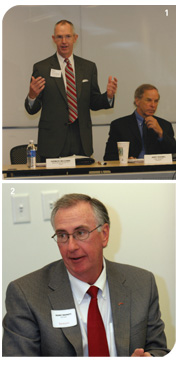
1: Pat McCown of McCownGordon welcomes participants to the 7th annual Philanthropy Industry Outlook Assembly. Ingram’s Executive Editor Jack Cashill served as the moderator of the meeting. | 2: Denny Barnett discusses how Citi Cards assesses proposals for funding that includes environmental concerns in addition to basic services.
In fact, there are many. The CEO of Catholic Charities of Kansas City – St. Joseph, Michael Halterman, noted that his organization has brought in nearly $15 million dollars in federal funds in the last two years, all through collaborations. “We have been highly successful in this,” said Halterman.
Susan Stanton, of the newly merged United Way of Greater Kansas City, shared another example. She spoke of Operation Breakthrough, a child care center for poor children, where she serves on the board. As she noted, the Seton Center, the Full Employment Council, KU Hospital, Children’s Mercy Hospital, Children’s TLC and Truman Medical Center all have provided services to the center.
“They do that,” said Susan Stanton, “because there is no ego and they are willing to share control or give up control.” She cautioned that such collaborations do not typically occur at those not-for-profits where ego reigns.
Kala Stroup of American Humanics offered the very specific example of her organization’s collaboration with Campfire USA, which also has its national headquarters in Kansas City. With support from the Hall Family Foundation, the two organizations moved downtown together and merged much of their operational infrastructure.
Cabot Westside Health Center, as executive director Liz Levin related, was lucky enough to get a grant from the REACH Foundation to support a collaboration between Guadalupe Center, Alta Vista High School, and Cabot. The result of this collaboration is the program Healthy Smiles, in which Cabot professionals con-duct dental health assessments for high school juniors and seniors, after which appropriate treatments and corrective ac-tions are taken to get the students smiling for their graduation pictures and beyond.
The question was raised as to whether non-profits follow market logic and go out of business when there is no longer adequate demand for the service they provide.
“I think [non-profits] can do that if it was simply a dollars and cents decision,” said Dan Purdom, the medical director of Samuel Rodgers Community Health Center. “But we have such a passion for the people that we serve. There is such a tremendous need in the population that lives around us and that comes to us for care that you can’t give up.”
“It isn’t always about dollars and cents,” agreed Pat McCown, while acknowledging the tension between a non- profit’s passion on the one hand and the bottom line on the other.
“The non-profit sector has a double bottom line so it’s never just about the finances,” affirmed Dave Renz, director of the Midwest Center for Non-Profit Leadership at UMKC.
He added that the philanthropic community is witnessing more consolidations and more closings now than in the recent past. As in business, too, Renz continued, there is a large number of not-for-profit start-ups, as many as 70,000 a year.
Mary Kay McPhee, representing the Local Investment Commission (LINC), elaborated that some of those organizations that have had to close—for instance, the Neighborhood Alliance and Ad Hoc Group Against Crime—filled an essential need.
“I thought it was really sad when that happened,” McPhee said of their closing. “I think that conceptually we will have to rethink those things and pull them back, maybe in a little bit different system.”
(...continued)